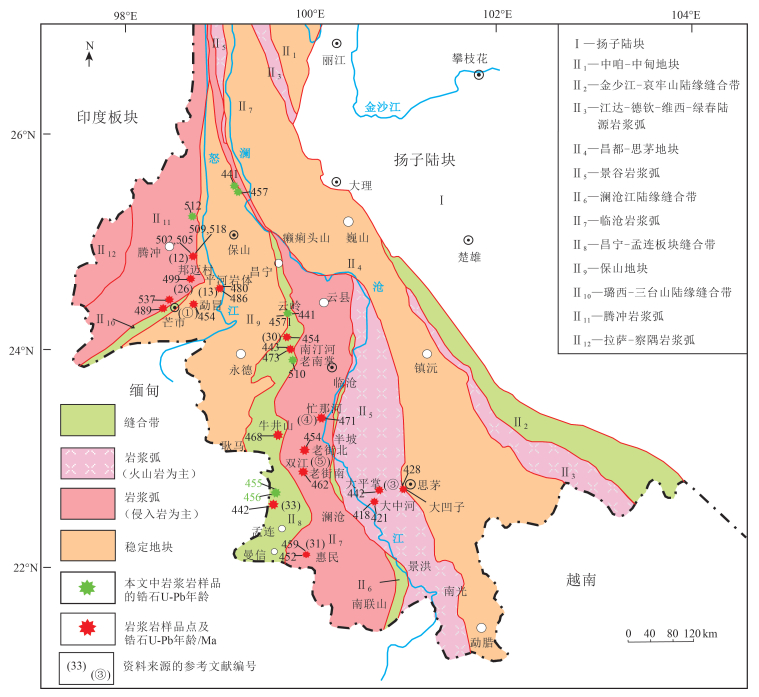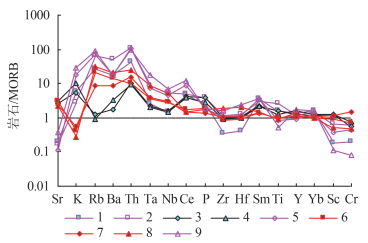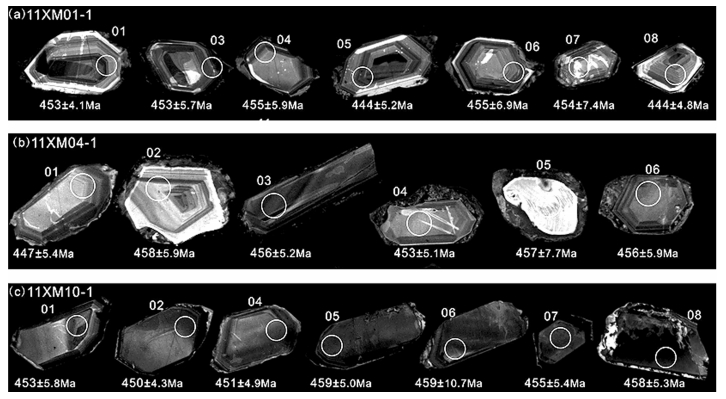Early Paleozoic magmatic event in the Sanjiang orogenic belt in southwest China and its response to the evolution of the Proto-Tethyan Ocean
-
摘要:
西南三江造山带由多条缝合带及其间多个大小不等的中间地块构成,大地构造位置处于欧亚板块和印度板块结合部位的特提斯构造域东段。在福贡县马吉乡古当河片麻状花岗岩、保山怒江坝镇西片麻岩、永德变质流纹岩、漕涧花岗岩岩体、西盟花岗片麻岩、澜沧基性-中基性火山岩中分别获得SHRIMP锆石U-Pb年龄为465±5 Ma、512±7 Ma、510±16 Ma、441~457 Ma、454~456 Ma、456~459 Ma,结合前人的西南三江地区早古生代岩浆岩年龄数据,昌宁-孟连特提斯大洋东西两侧都有中—晚奥陶世侵入岩,岩石地球化学特征表明,侵入岩具岛弧特征。昌宁-孟连特提斯大洋西缘的保山地块内部及东部有寒武纪火山岩,具双峰式特征,为拉张环境形成,表明特提斯大洋在寒武纪还在扩张。至中奥陶世,构造体制开始转变,大洋板块向东、西两大陆开始俯冲,在其大陆边缘形成岛弧。
Abstract:The Sanjiang orogenic belt in southwest China is composed of several sutures and many intermediate massifs of different sizes.It is tectonically located in the eastern part of Tethys structural domain where Eurasia plate and India plate joint.Zircon U-Pb dating of samples collected from Gudanghe gneissic granite, Nujiangba Town gneiss, Yongde metamorphic rhyolite, Caojian granite, Ximeng granitic gneiss and Lancang basic medium basic volcanic rocks in Maji Town of Fugong County yielded 465±5 Ma, 512±7 Ma, 510±16 Ma, 441~457 Ma, 454~456 Ma, 456~459 Ma respectively.Combined with the age data of the early Paleozoic magmatic rocks in thSanjiang area, Southwest China, middle Late Ordovician intrusives with island arc characteristics were emplaced on the east and west sides of the Changlian-menglian Tethys Ocean.The Cambrian volcanic rocks with two peaks in the interior and east of Baoshan massif in the western margin of Changlian-Menglian Tethys ocean revealing tension environment indicate that the Tethys ocean existed in Cambrian and is still expanding.In the Middle Ordovician, the tectonic system began to change, and the oceanic plates began to subduct toward east and west, forming island arcs on the continental margin.
-
Keywords:
- Sanjiang /
- Early Paleozoic /
- magmatic event /
- tectonics
-
-
图 5 槽涧岩体花岗岩A/CNK-A/NK图解②
Figure 5. A/CNK-A/NK diagram of granite in Caojian pluton
-
刘本培, 冯庆来, Chonglakmani C, 等. 滇西古特提斯多岛洋的结构及其南北延伸[J]. 地学前缘, 2002, (3): 161-171. doi: 10.3321/j.issn:1005-2321.2002.03.020 黄汲清, 陈国铭, 陈炳蔚. 中国及邻区特提斯海的演化[M]. 北京: 地质出版社, 1987. 云南省地质矿产局. 云南省区域地质志[M]. 北京: 地质出版社, 1990. 王义昭. 滇西昌宁-孟连带南部孟连-曼信地区晚古生代地层若干问题[J]. 地质论评, 2005, 51(1): 1-9. doi: 10.3321/j.issn:0371-5736.2005.01.001 王立全, 潘桂棠, 丁俊, 等. 青藏高原及邻区地质图及说明书(1: 1 500 000)[M]. 北京: 地质出版社, 2013. 王立全, 潘桂棠, 李才, 等. 藏北羌塘中部果干加年山早古生代堆晶辉长岩的锆石SHRIMP U-Pb年龄——兼论原-古特提斯洋的演化[J]. 地质通报, 2008, 27(12): 2045-2056. doi: 10.3969/j.issn.1671-2552.2008.12.010 李文昌, 潘桂棠, 侯增谦, 等. 西南"三江"多岛弧盆-碰撞造山成矿理论与勘查技术[M]. 北京: 地质出版社, 2010. 潘桂棠, 王立全, 张万平, 等. 青藏高原及邻区大地构造图及说明书(1: 1 500 000)[M]. 北京: 地质出版社, 2013. 王冬兵, 罗亮, 唐渊, 等. 昌宁-孟连结合带牛井山早古生代埃达克岩锆石U-Pb年龄、岩石成因及其地质意义[J]. 岩石学报, 2016, 32(8), 2317-2329. https://www.cnki.com.cn/Article/CJFDTOTAL-YSXB201608006.htm Wang B D, Wang L Q, Pan G T, et al. U-Pb zircon dating of Early Paleozoic gabbro from the Nantinghe ophiolite in the Changning-Menglian suture zone and its geological implication[J]. Chinese Science Bulletin, 2013, 58(8): 920-930. doi: 10.1007/s11434-012-5481-8
林仕良, 丛峰, 高永娟, 等. 滇西腾冲地块东南缘高黎贡山群片麻岩LA-ICP-MS锆石U-Pb年龄及其地质意义[J]. 地质通报, 2012, 31(s1): 258-263. http://dzhtb.cgs.cn/gbc/ch/reader/view_abstract.aspx?file_no=2012020307&flag=1 Liu S, Hu R, Gao S, et al. U-Pb zircon, geochemical and Sr-Nd-Hf isotopic constraints on the age and origin of Early Palaeozoic I-type granite from the Tengchong-Baoshan Block, Western Yunnan Province, SW China[J]. Journal of Asian Earth Sciences, 2009, 36(2/3): 168-182.
董美玲, 董国臣, 莫宣学, 等. 滇西保山地块早古生代花岗岩类的年代学、地球化学及意义[J]. 岩石学报, 2012, 28(5): 1453-1464. https://www.cnki.com.cn/Article/CJFDTOTAL-YSXB201205011.htm Dong M L, Dong G C, Mo X X, et al. Geochemistry, zircon U-Pb geochronology and Hf isotopes of granites in the Baoshan Block, Western Yunnan: Implications for Early Paleozoic evolution along the Gondwana margin[J]. Lithos, 2013, 179(5): 36-47.
蔡志慧, 许志琴, 段向东, 等. 青藏高原东南缘滇西早古生代早期造山事件[J]. 岩石学报, 2013, 29(6): 2123-2140. https://www.cnki.com.cn/Article/CJFDTOTAL-YSXB201306020.htm 王保弟, 王立全, 王冬兵, 等. 三江昌宁-孟连带原-古特提斯构造演化[J]. 地球科学, 2018, 43(8): 2527-2550. https://www.cnki.com.cn/Article/CJFDTOTAL-DQKX201808001.htm 尹福光, 潘桂棠, 万方, 等. 西南"三江"造山带大地构造相[J]. 沉积与特提斯地质, 2006, (4): 33-39. doi: 10.3969/j.issn.1009-3850.2006.04.005 尹福光, 王冬兵, 王保弟, 等. 西南三江造山带地层区划[J]. 沉积与特提斯地质, 2017, 37(4): 1-8. doi: 10.3969/j.issn.1009-3850.2017.04.002 任飞, 潘桂棠, 尹福光, 等. 西南三江地区洋板块地层特征及构造演化[J]. 沉积与特提斯地质, 2017, 37(4): 9-16. doi: 10.3969/j.issn.1009-3850.2017.04.003 沈上越, 冯庆来, 刘本培, 等. 昌宁-孟连带洋脊、洋岛型火山岩研究[J]. 地质科技情报, 2002, 21(3): 13-17. doi: 10.3969/j.issn.1000-7849.2002.03.003 李三忠, 赵淑娟, 余珊, 等. 东亚原特提斯洋(Ⅱ): 早古生代微陆块亲缘性与聚合[J]. 岩石学报, 2016, 32(9): 2628-2644. https://www.cnki.com.cn/Article/CJFDTOTAL-YSXB201609003.htm 潘桂棠, 陈智良, 李兴振, 等. 东特提斯地质构造形成演化[M]. 北京: 地质出版社, 1997. 潘桂棠, 徐强, 侯增谦, 等. 西南"三江"多岛弧造山过程成矿系统与资源评价[M]. 北京: 地质出版社, 2003. 潘桂棠, 徐耀荣, 王培生. 青藏高原东部边缘新生代构造[C]//青藏高原地质文集(12). 北京: 地质出版社, 1983: 129-141. 潘桂棠, 刘宇平, 郑来林, 等. 青藏高原碰撞构造及其效应[M]. 广州: 广东科技出版社, 2013. 莫宣学, 路凤香, 沈上越. 三江特提斯火山作用与成矿[M]. 北京: 地质出版社, 1993. Jian P, Liu D, Sun X. SHRIMP dating of the Permo-Carboniferous Jinshajiang ophiolite, southwestern China: Geochronological constraints for the evolution of Paleo-Tethys[J]. Journal of Asian Earth Sciences, 2008, 32(5/6): 1-384. http://www.sciencedirect.com/science/article/pii/S1367912007002234
王立全, 潘桂棠, 李才, 等. 藏北羌塘中部果干加年山早古生代堆晶辉长岩的锆石SHRIMP U-Pb年龄——兼论原-古特提斯洋的演化[J]. 地质通报, 2008, 27(12): 2045-2056. doi: 10.3969/j.issn.1671-2552.2008.12.010 毛晓长, 王立全, 李冰, 等. 云县-景谷火山弧带大中河晚志留世火山岩的发现及其地质意义[J]. 岩石学报, 2012, 28(5): 1517-1528. https://www.cnki.com.cn/Article/CJFDTOTAL-YSXB201205016.htm 王保弟, 王立全, 潘桂棠, 等. 昌宁-孟连结合带南汀河早古生代辉长岩锆石年代学及地质意义[J]. 科学通报, 2013, 58(4): 344-354. https://www.cnki.com.cn/Article/CJFDTOTAL-KXTB201304009.htm Nie X M, Feng Q L, Qian X, et al. Magmatic record of Prototethy an evolution in SW Yunnan, China: Geochemical, zircon U-Pb geochronological and Lu-Hf isotopic evidence from the Huimin metavolcanic rocks in the southern Lancangjiang zone[J]. Gondwana Research, 2015, 28(2): 757-768. doi: 10.1016/j.gr.2014.05.011
Xing X W, Wang Y J, Cawood P A, et al. Early Paleozoic accretionary orogenesis along northern margin of Gondwana constrained by high-Mg metaigneous rocks, SW Yunnan[J]. Internation Journalof Earth Sciences, 2017, 106(5): 1469-1486. doi: 10.1007/s00531-015-1282-z
康欢, 李大鹏, 陈岳龙, 等. 云南宝山东缘早古生代高Si花岗岩的成因及构造意义[J]. 现代地质, 2016, 30(5): 1026-1038. doi: 10.3969/j.issn.1000-8527.2016.05.008 宋述光, 季建清, 魏春景, 等. 滇西北怒江早古生代片麻状花岗岩的确定及其构造意义[J]. 科学通报, 2007, 52(8): 927-930. doi: 10.3321/j.issn:0023-074X.2007.08.013 Shen L, Hu R Z, Shan G, et al. U-Pb zircon, geochemical and Sr-Nd-Hf isotopic constraints on the age and origin of Early Palaeozoic I-type granite from the Tengchong-Baoshan Block, Western Yunnan Province, SW China[J]. Journal of Asian Earth Sciences, 2009, 36(2): 168-182.
毛晓长. 保山-镇康地块及邻区早古生代地质特征及特提斯构造演化[D]. 中国地质大学博士学位论文, 2016. 邢晓婉, 张玉芝, 王岳军, 等. 西盟地区奥陶纪花岗片麻岩的锆石U-Pb年代学、Hf同位素组成特征及其大地构造意义[J]. 大地构造与成矿学, 2015, 39(3): 470-480. https://www.cnki.com.cn/Article/CJFDTOTAL-DGYK201503011.htm 鲁慧, 孙载波, 张虎, 等. 云南西盟曼亨花岗岩锆石U-Pb年龄与地质意义[J]. 矿物学报, 2015, 35(4): 515-521. https://www.cnki.com.cn/Article/CJFDTOTAL-KWXB201504016.htm 孙载波, 曾文涛, 周坤, 等. 孟连结合带奥陶纪洋岛玄武岩的识别及其构造意义——来自地球化学和锆石U-Pb年龄的证据[J]. 地质通报, 2017, 36(10): 1760-1771. doi: 10.3969/j.issn.1671-2552.2017.10.008 刘桂春, 孙载波, 曾文涛, 等. 湾河蛇绿混杂岩的形成时代、岩石地球化学特征及地质意义[J]. 岩石矿物学杂志, 2017, 36(2): 163-174. doi: 10.3969/j.issn.1000-6524.2017.02.003 李静, 孙载波, 徐桂香, 等. 滇西双江县勐库地区榴闪岩的发现与厘定[J]. 矿物学报, 2015, 35(4): 421-424. https://www.cnki.com.cn/Article/CJFDTOTAL-KWXB201504001.htm 李才, 吴彦旺, 王明, 等. 青藏高原泛非-早古生代造山事件研究重大进展——冈底斯地区寒武系和泛非造山不整合的发现[J]. 地质通报, 2010, 29(12): 1733-1736. doi: 10.3969/j.issn.1671-2552.2010.12.001 朱弟成, 赵志丹, 牛耀龄, 等. 拉萨地体的起源和古生代构造演化[J]. 高校地质学报, 2012, 18(1): 1-15. doi: 10.3969/j.issn.1006-7493.2012.01.001 Wang B D, Wang L Q, Yin F G, et al. Longmuco-Shuanghu-Changning-Menglian Suture Zone: Residual of Uniform Early Paleozoic Tethys Ocean[J]. Acta Geological Sinica. 2013, 87(zl): 72-75. http://www.geojournals.cn/dzxbcn/ch/reader/view_abstract.aspx?file_no=dzxben2003z10040&flag=1
李朋武, 高锐, 崔军文, 等. 西藏和云南三江地区特提斯洋盆演化历史的古地磁分析[J]. 地球学报, 2005, (5): 3-20. https://www.cnki.com.cn/Article/CJFDTOTAL-DQXB200505000.htm 孙载波, 胡绍斌, 周坤, 等. 滇西南勐海布朗山奥陶纪花岗岩锆石U-Pb年龄、Hf同位素组成特征及其构造意义[J]. 地质通报, 2018, 37(11): 2044-2054. http://dzhtb.cgs.cn/gbc/ch/reader/view_abstract.aspx?file_no=20181110&flag=1 潘桂棠, 李兴振, 王立全, 等. 青藏高原及邻区大地构造单元初步划分[J]. 地质通报, 2002, 21(1): 701-707. http://dzhtb.cgs.cn/gbc/ch/reader/view_abstract.aspx?file_no=2002011160&flag=1 翟明国, 从柏林, 张儒媛. 滇西澜沧群两类火山岩系的识别及其地质意义[J]. 中国科学(B辑), 1990, (1): 77-85. https://www.cnki.com.cn/Article/CJFDTOTAL-JBXK199001012.htm Zhu D, Zhao Z, Niu Y, et al. The origin and pre-Cenozoic evolution of the Tibetan Plateau[J]. Gondwana research, 2013, 23(4): 1429-1454. doi: 10.1016/j.gr.2012.02.002
Dario V, Rubatto D, Villa I M. The mafic rocks of Shao La (Kharta, S. Tibet): Ordovician basaltic magmatism in the greater himalayan crystallines of central-eastern Himalaya[J]. Journal of Asian Earth Sciences, 2010, 38(1/2): 1-25. http://www.sciencedirect.com/science/article/pii/S1367912009002570
尹福光, 王冬兵, 唐渊, 等西南三江南段关键地区区域地质调查综合研究报告, 2015. 中国地质调查局成都地质调查中心. 中华人民共和国1: 5万大芒光房幅、双江县幅、文东幅区域地质调查报告, 2019. 云南地质调查研究院. 中华人民共和国1: 25万腾冲县幅(国内部分)、潞西市幅(国内部分)区域地质调查报告, 2008. 重庆市地勘局川东南地质大队. 头道水幅、涌宝幅、蚂蚁堆幅、大寨幅区域地质矿产调查报告, 2016. 成都理工大学. 中华人民共和国1: 5万临沧幅、博尚幅、民乐幅区域地质矿产调查报告, 2019. 中国地质调查局成都地质调查中心. 中华人民共和国1: 5万圈内幅、翁孔坝幅、忙糯幅区域地质调查报告, 2019.




 下载:
下载:







